Comprehensive Report on Internet Usage in Micronesia: A Survey
VerifiedAdded on 2021/04/19
|12
|2816
|55
Report
AI Summary
This report presents a comprehensive analysis of internet usage among the people of Micronesia, focusing on a survey conducted on individuals aged 18-30. The study explores various aspects, including the level of internet dependency and addiction, the differentiation between genders and age groups in internet usage, the association between internet usage and education/occupation, and the potential behavioral, physical, and psychological impacts. The methodology involves a non-probability sampling technique, specifically judgmental sampling, to gather data. The research questions delve into dependency, gender disparities, educational/occupational influences, behavioral issues, and the positive impacts of internet usage. The report also examines five demographic variables: gender, grade, monthly wage, internet experience, and computer training, and their influence on internet usage patterns. Survey questions address internet usage for educational/work purposes, entertainment, duration of use, gender disparities, and the impact of internet on the population's knowledge and psychological well-being. The report highlights the importance of internet accessibility for daily activities, social networking, and work. It also discusses gender disparities in internet use, the impact of working adults compared to younger adults, and the influence of income and education. The report concludes by acknowledging the potential negative consequences of excessive internet usage, such as cyberbullying and its impact on mental health, while also recognizing the benefits such as improved quality of life.
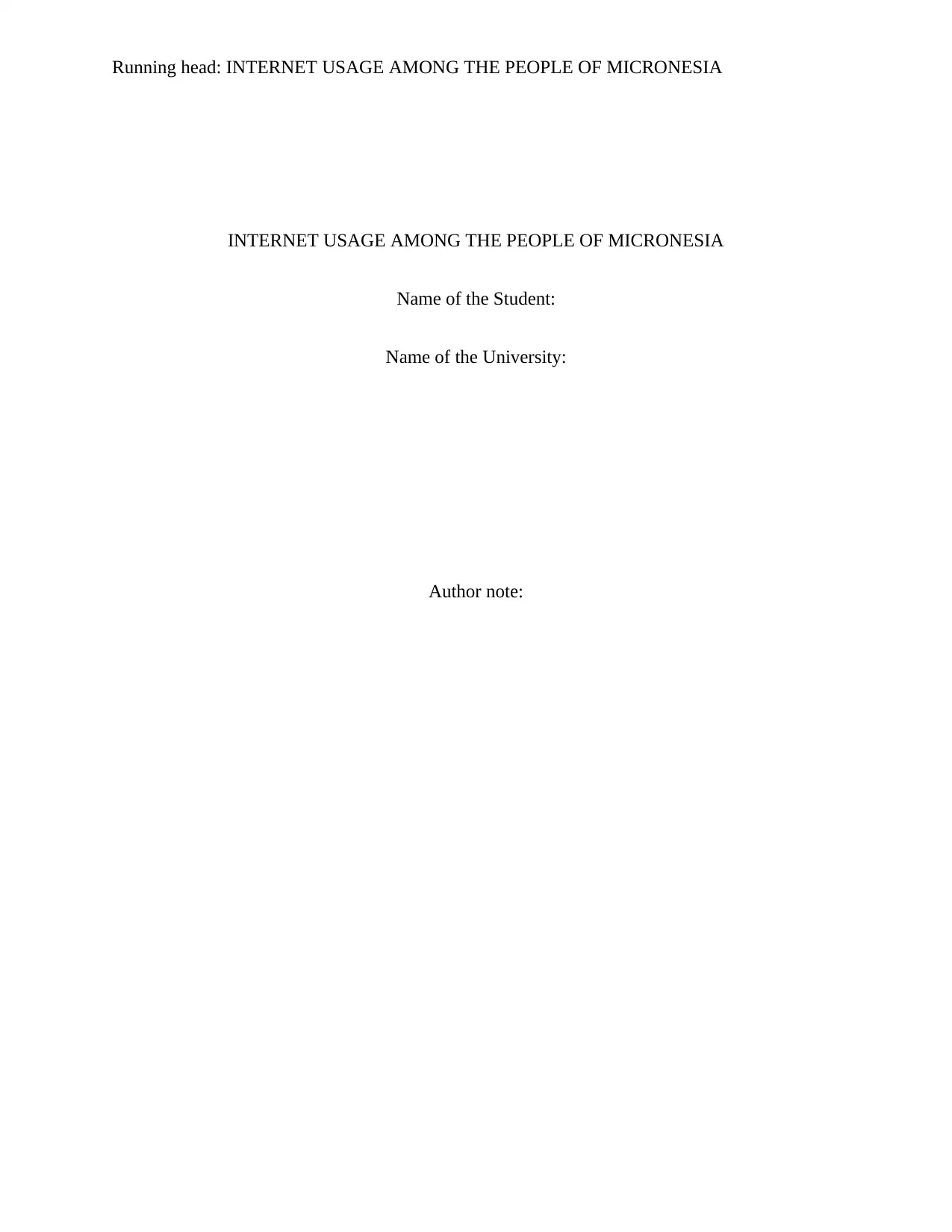
Running head: INTERNET USAGE AMONG THE PEOPLE OF MICRONESIA
INTERNET USAGE AMONG THE PEOPLE OF MICRONESIA
Name of the Student:
Name of the University:
Author note:
INTERNET USAGE AMONG THE PEOPLE OF MICRONESIA
Name of the Student:
Name of the University:
Author note:
Paraphrase This Document
Need a fresh take? Get an instant paraphrase of this document with our AI Paraphraser
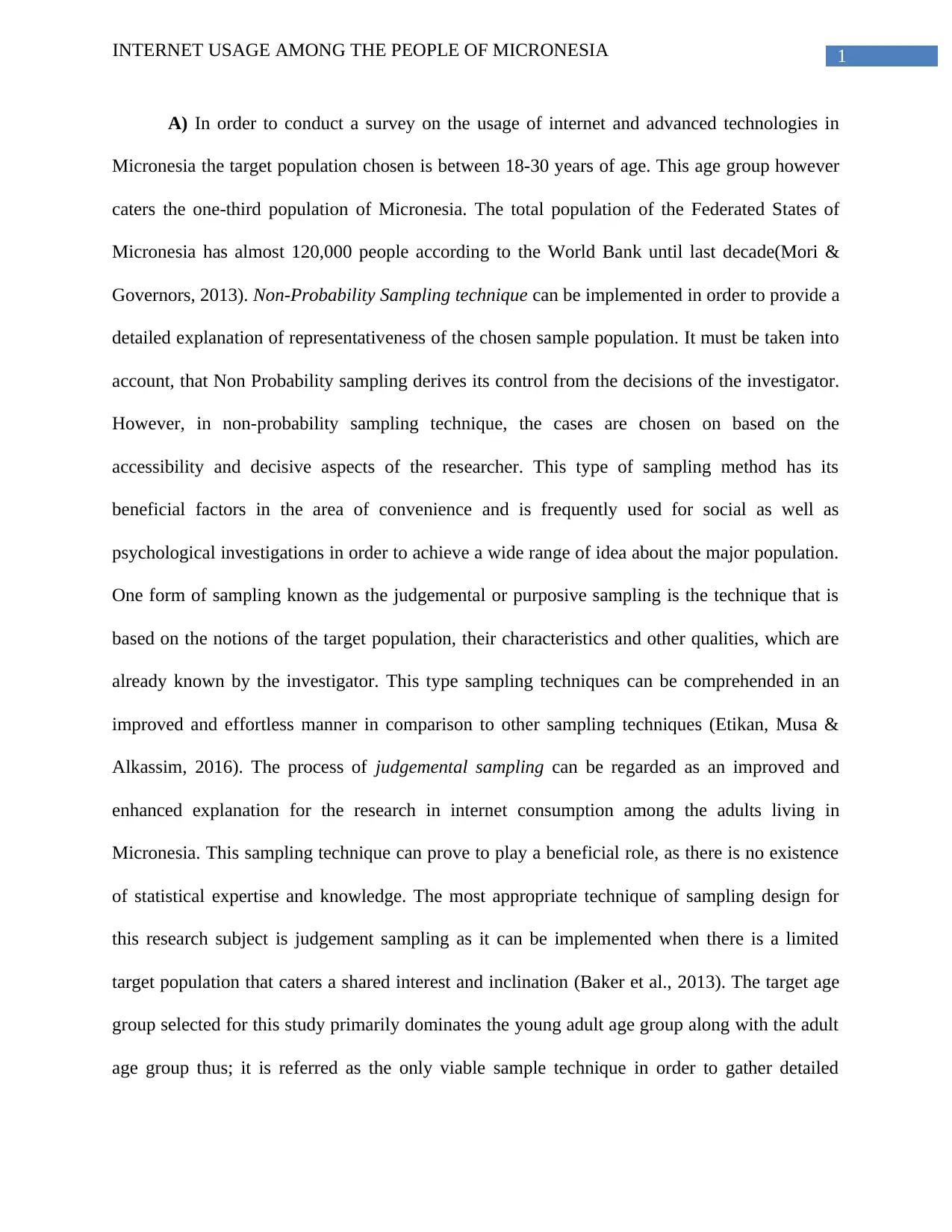
1INTERNET USAGE AMONG THE PEOPLE OF MICRONESIA
A) In order to conduct a survey on the usage of internet and advanced technologies in
Micronesia the target population chosen is between 18-30 years of age. This age group however
caters the one-third population of Micronesia. The total population of the Federated States of
Micronesia has almost 120,000 people according to the World Bank until last decade(Mori &
Governors, 2013). Non-Probability Sampling technique can be implemented in order to provide a
detailed explanation of representativeness of the chosen sample population. It must be taken into
account, that Non Probability sampling derives its control from the decisions of the investigator.
However, in non-probability sampling technique, the cases are chosen on based on the
accessibility and decisive aspects of the researcher. This type of sampling method has its
beneficial factors in the area of convenience and is frequently used for social as well as
psychological investigations in order to achieve a wide range of idea about the major population.
One form of sampling known as the judgemental or purposive sampling is the technique that is
based on the notions of the target population, their characteristics and other qualities, which are
already known by the investigator. This type sampling techniques can be comprehended in an
improved and effortless manner in comparison to other sampling techniques (Etikan, Musa &
Alkassim, 2016). The process of judgemental sampling can be regarded as an improved and
enhanced explanation for the research in internet consumption among the adults living in
Micronesia. This sampling technique can prove to play a beneficial role, as there is no existence
of statistical expertise and knowledge. The most appropriate technique of sampling design for
this research subject is judgement sampling as it can be implemented when there is a limited
target population that caters a shared interest and inclination (Baker et al., 2013). The target age
group selected for this study primarily dominates the young adult age group along with the adult
age group thus; it is referred as the only viable sample technique in order to gather detailed
A) In order to conduct a survey on the usage of internet and advanced technologies in
Micronesia the target population chosen is between 18-30 years of age. This age group however
caters the one-third population of Micronesia. The total population of the Federated States of
Micronesia has almost 120,000 people according to the World Bank until last decade(Mori &
Governors, 2013). Non-Probability Sampling technique can be implemented in order to provide a
detailed explanation of representativeness of the chosen sample population. It must be taken into
account, that Non Probability sampling derives its control from the decisions of the investigator.
However, in non-probability sampling technique, the cases are chosen on based on the
accessibility and decisive aspects of the researcher. This type of sampling method has its
beneficial factors in the area of convenience and is frequently used for social as well as
psychological investigations in order to achieve a wide range of idea about the major population.
One form of sampling known as the judgemental or purposive sampling is the technique that is
based on the notions of the target population, their characteristics and other qualities, which are
already known by the investigator. This type sampling techniques can be comprehended in an
improved and effortless manner in comparison to other sampling techniques (Etikan, Musa &
Alkassim, 2016). The process of judgemental sampling can be regarded as an improved and
enhanced explanation for the research in internet consumption among the adults living in
Micronesia. This sampling technique can prove to play a beneficial role, as there is no existence
of statistical expertise and knowledge. The most appropriate technique of sampling design for
this research subject is judgement sampling as it can be implemented when there is a limited
target population that caters a shared interest and inclination (Baker et al., 2013). The target age
group selected for this study primarily dominates the young adult age group along with the adult
age group thus; it is referred as the only viable sample technique in order to gather detailed
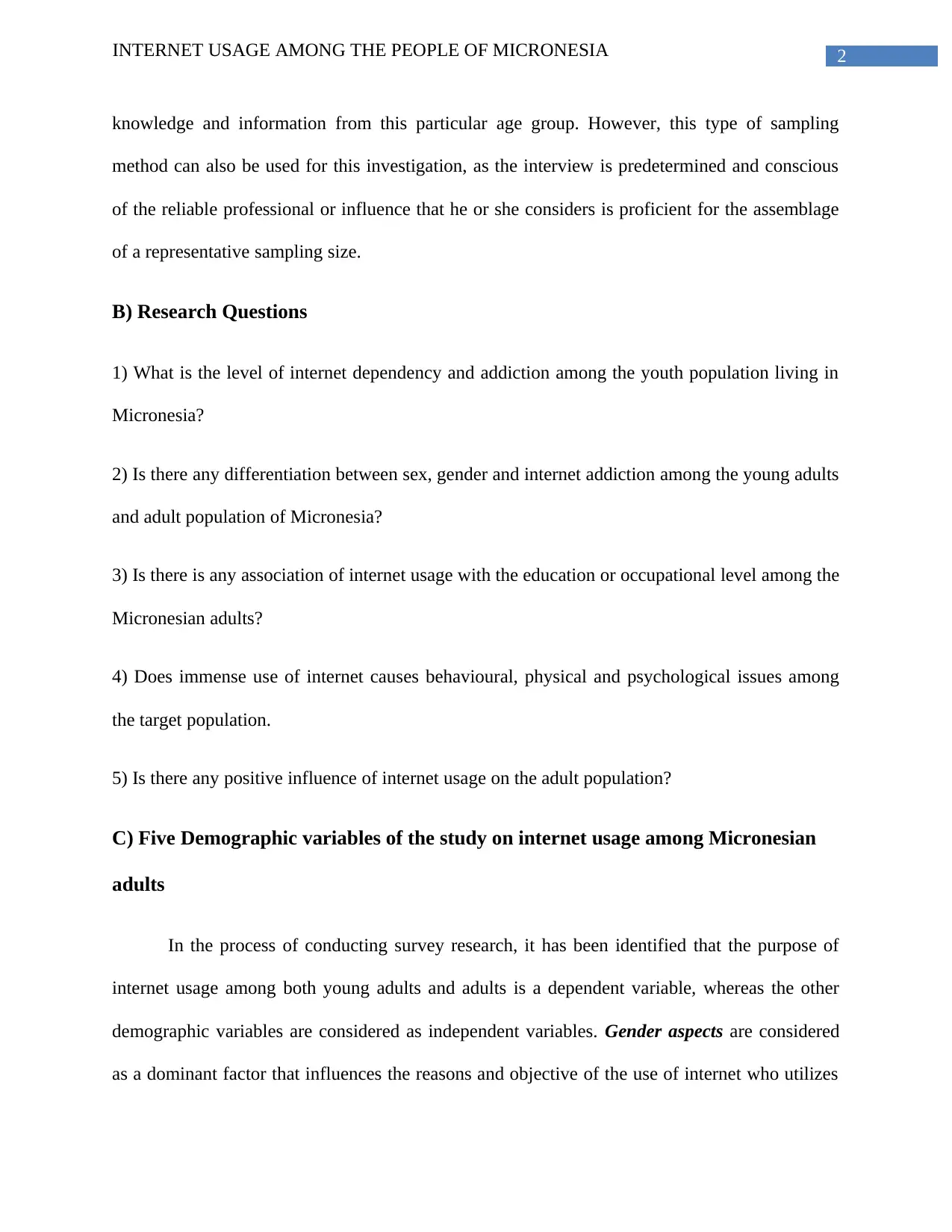
2INTERNET USAGE AMONG THE PEOPLE OF MICRONESIA
knowledge and information from this particular age group. However, this type of sampling
method can also be used for this investigation, as the interview is predetermined and conscious
of the reliable professional or influence that he or she considers is proficient for the assemblage
of a representative sampling size.
B) Research Questions
1) What is the level of internet dependency and addiction among the youth population living in
Micronesia?
2) Is there any differentiation between sex, gender and internet addiction among the young adults
and adult population of Micronesia?
3) Is there is any association of internet usage with the education or occupational level among the
Micronesian adults?
4) Does immense use of internet causes behavioural, physical and psychological issues among
the target population.
5) Is there any positive influence of internet usage on the adult population?
C) Five Demographic variables of the study on internet usage among Micronesian
adults
In the process of conducting survey research, it has been identified that the purpose of
internet usage among both young adults and adults is a dependent variable, whereas the other
demographic variables are considered as independent variables. Gender aspects are considered
as a dominant factor that influences the reasons and objective of the use of internet who utilizes
knowledge and information from this particular age group. However, this type of sampling
method can also be used for this investigation, as the interview is predetermined and conscious
of the reliable professional or influence that he or she considers is proficient for the assemblage
of a representative sampling size.
B) Research Questions
1) What is the level of internet dependency and addiction among the youth population living in
Micronesia?
2) Is there any differentiation between sex, gender and internet addiction among the young adults
and adult population of Micronesia?
3) Is there is any association of internet usage with the education or occupational level among the
Micronesian adults?
4) Does immense use of internet causes behavioural, physical and psychological issues among
the target population.
5) Is there any positive influence of internet usage on the adult population?
C) Five Demographic variables of the study on internet usage among Micronesian
adults
In the process of conducting survey research, it has been identified that the purpose of
internet usage among both young adults and adults is a dependent variable, whereas the other
demographic variables are considered as independent variables. Gender aspects are considered
as a dominant factor that influences the reasons and objective of the use of internet who utilizes
You're viewing a preview
Unlock full access by subscribing today!
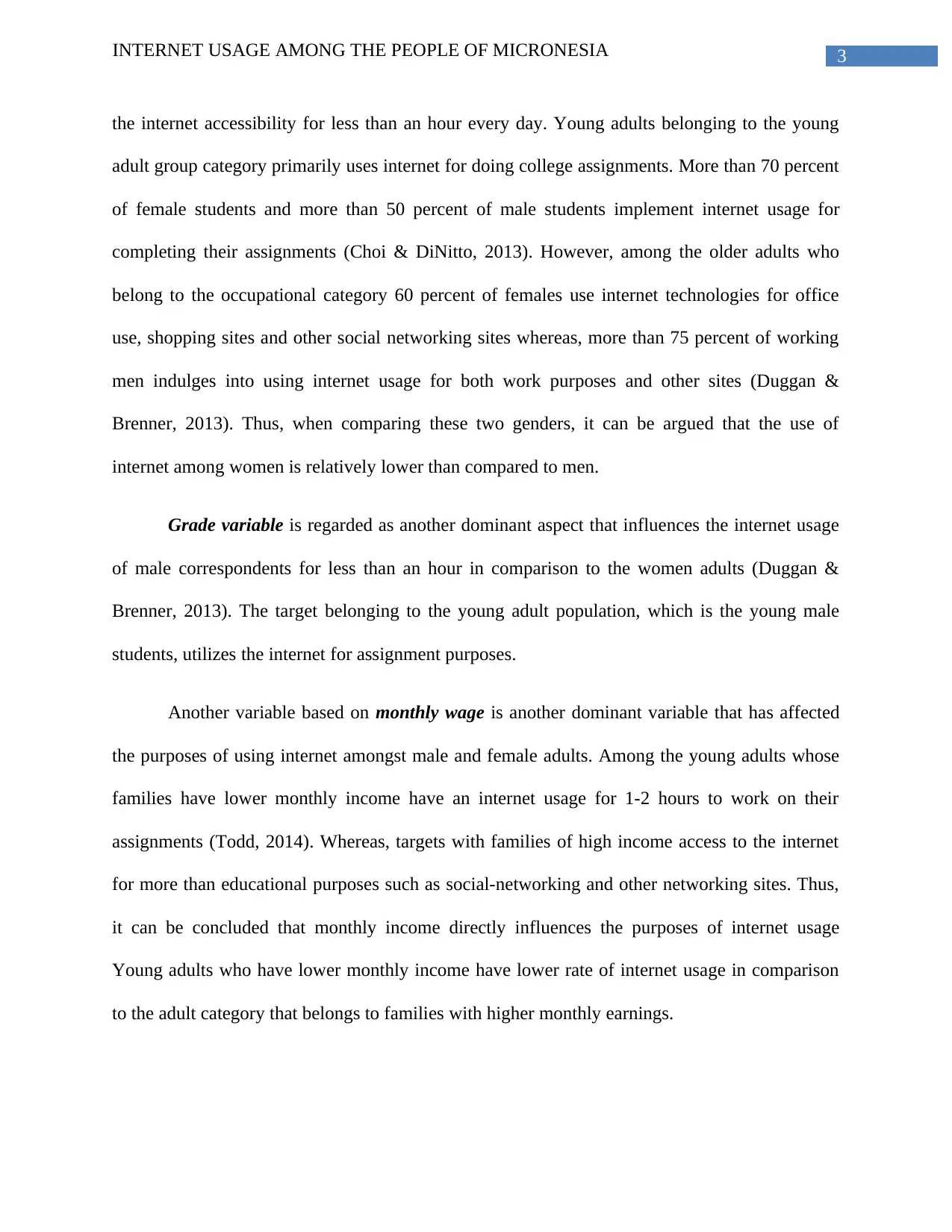
3INTERNET USAGE AMONG THE PEOPLE OF MICRONESIA
the internet accessibility for less than an hour every day. Young adults belonging to the young
adult group category primarily uses internet for doing college assignments. More than 70 percent
of female students and more than 50 percent of male students implement internet usage for
completing their assignments (Choi & DiNitto, 2013). However, among the older adults who
belong to the occupational category 60 percent of females use internet technologies for office
use, shopping sites and other social networking sites whereas, more than 75 percent of working
men indulges into using internet usage for both work purposes and other sites (Duggan &
Brenner, 2013). Thus, when comparing these two genders, it can be argued that the use of
internet among women is relatively lower than compared to men.
Grade variable is regarded as another dominant aspect that influences the internet usage
of male correspondents for less than an hour in comparison to the women adults (Duggan &
Brenner, 2013). The target belonging to the young adult population, which is the young male
students, utilizes the internet for assignment purposes.
Another variable based on monthly wage is another dominant variable that has affected
the purposes of using internet amongst male and female adults. Among the young adults whose
families have lower monthly income have an internet usage for 1-2 hours to work on their
assignments (Todd, 2014). Whereas, targets with families of high income access to the internet
for more than educational purposes such as social-networking and other networking sites. Thus,
it can be concluded that monthly income directly influences the purposes of internet usage
Young adults who have lower monthly income have lower rate of internet usage in comparison
to the adult category that belongs to families with higher monthly earnings.
the internet accessibility for less than an hour every day. Young adults belonging to the young
adult group category primarily uses internet for doing college assignments. More than 70 percent
of female students and more than 50 percent of male students implement internet usage for
completing their assignments (Choi & DiNitto, 2013). However, among the older adults who
belong to the occupational category 60 percent of females use internet technologies for office
use, shopping sites and other social networking sites whereas, more than 75 percent of working
men indulges into using internet usage for both work purposes and other sites (Duggan &
Brenner, 2013). Thus, when comparing these two genders, it can be argued that the use of
internet among women is relatively lower than compared to men.
Grade variable is regarded as another dominant aspect that influences the internet usage
of male correspondents for less than an hour in comparison to the women adults (Duggan &
Brenner, 2013). The target belonging to the young adult population, which is the young male
students, utilizes the internet for assignment purposes.
Another variable based on monthly wage is another dominant variable that has affected
the purposes of using internet amongst male and female adults. Among the young adults whose
families have lower monthly income have an internet usage for 1-2 hours to work on their
assignments (Todd, 2014). Whereas, targets with families of high income access to the internet
for more than educational purposes such as social-networking and other networking sites. Thus,
it can be concluded that monthly income directly influences the purposes of internet usage
Young adults who have lower monthly income have lower rate of internet usage in comparison
to the adult category that belongs to families with higher monthly earnings.
Paraphrase This Document
Need a fresh take? Get an instant paraphrase of this document with our AI Paraphraser
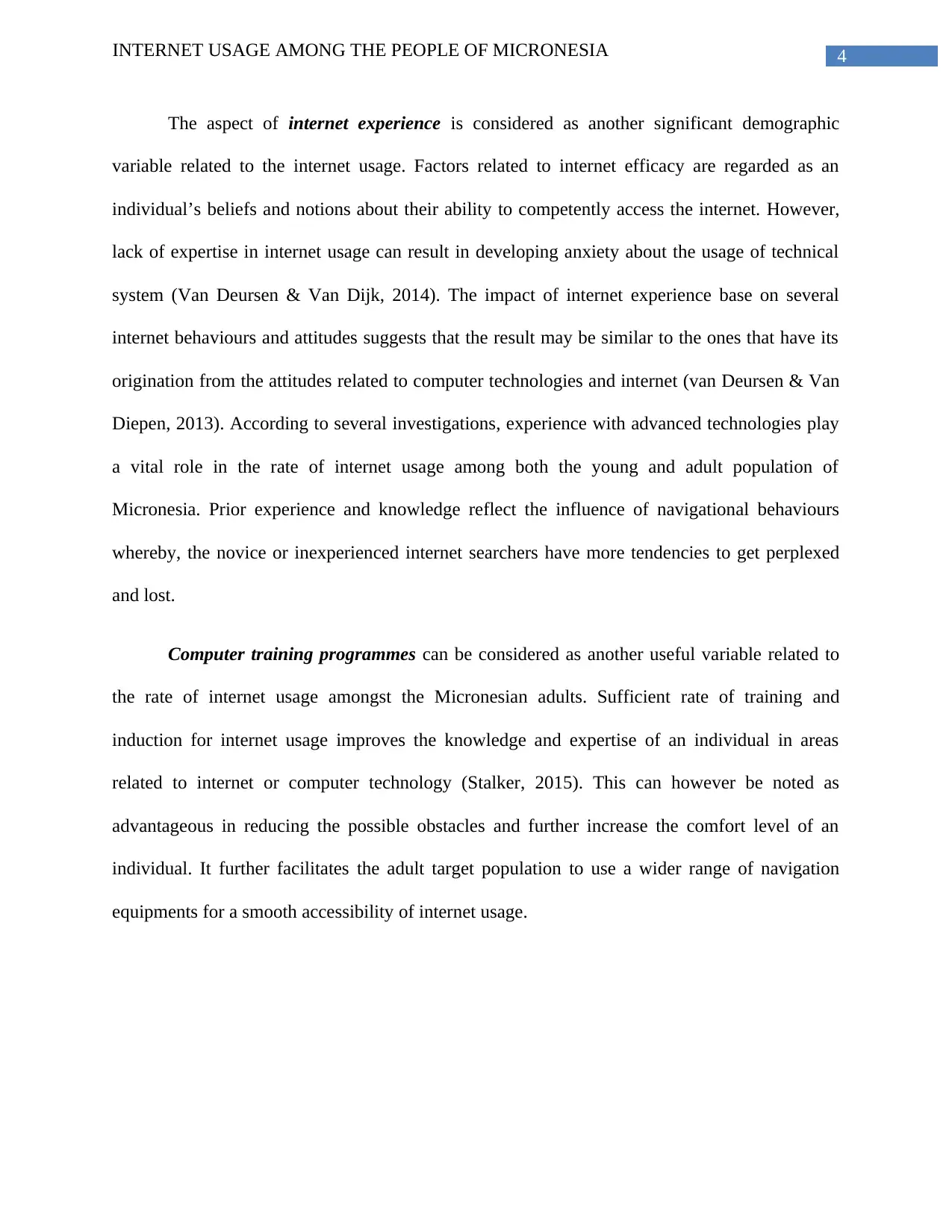
4INTERNET USAGE AMONG THE PEOPLE OF MICRONESIA
The aspect of internet experience is considered as another significant demographic
variable related to the internet usage. Factors related to internet efficacy are regarded as an
individual’s beliefs and notions about their ability to competently access the internet. However,
lack of expertise in internet usage can result in developing anxiety about the usage of technical
system (Van Deursen & Van Dijk, 2014). The impact of internet experience base on several
internet behaviours and attitudes suggests that the result may be similar to the ones that have its
origination from the attitudes related to computer technologies and internet (van Deursen & Van
Diepen, 2013). According to several investigations, experience with advanced technologies play
a vital role in the rate of internet usage among both the young and adult population of
Micronesia. Prior experience and knowledge reflect the influence of navigational behaviours
whereby, the novice or inexperienced internet searchers have more tendencies to get perplexed
and lost.
Computer training programmes can be considered as another useful variable related to
the rate of internet usage amongst the Micronesian adults. Sufficient rate of training and
induction for internet usage improves the knowledge and expertise of an individual in areas
related to internet or computer technology (Stalker, 2015). This can however be noted as
advantageous in reducing the possible obstacles and further increase the comfort level of an
individual. It further facilitates the adult target population to use a wider range of navigation
equipments for a smooth accessibility of internet usage.
The aspect of internet experience is considered as another significant demographic
variable related to the internet usage. Factors related to internet efficacy are regarded as an
individual’s beliefs and notions about their ability to competently access the internet. However,
lack of expertise in internet usage can result in developing anxiety about the usage of technical
system (Van Deursen & Van Dijk, 2014). The impact of internet experience base on several
internet behaviours and attitudes suggests that the result may be similar to the ones that have its
origination from the attitudes related to computer technologies and internet (van Deursen & Van
Diepen, 2013). According to several investigations, experience with advanced technologies play
a vital role in the rate of internet usage among both the young and adult population of
Micronesia. Prior experience and knowledge reflect the influence of navigational behaviours
whereby, the novice or inexperienced internet searchers have more tendencies to get perplexed
and lost.
Computer training programmes can be considered as another useful variable related to
the rate of internet usage amongst the Micronesian adults. Sufficient rate of training and
induction for internet usage improves the knowledge and expertise of an individual in areas
related to internet or computer technology (Stalker, 2015). This can however be noted as
advantageous in reducing the possible obstacles and further increase the comfort level of an
individual. It further facilitates the adult target population to use a wider range of navigation
equipments for a smooth accessibility of internet usage.
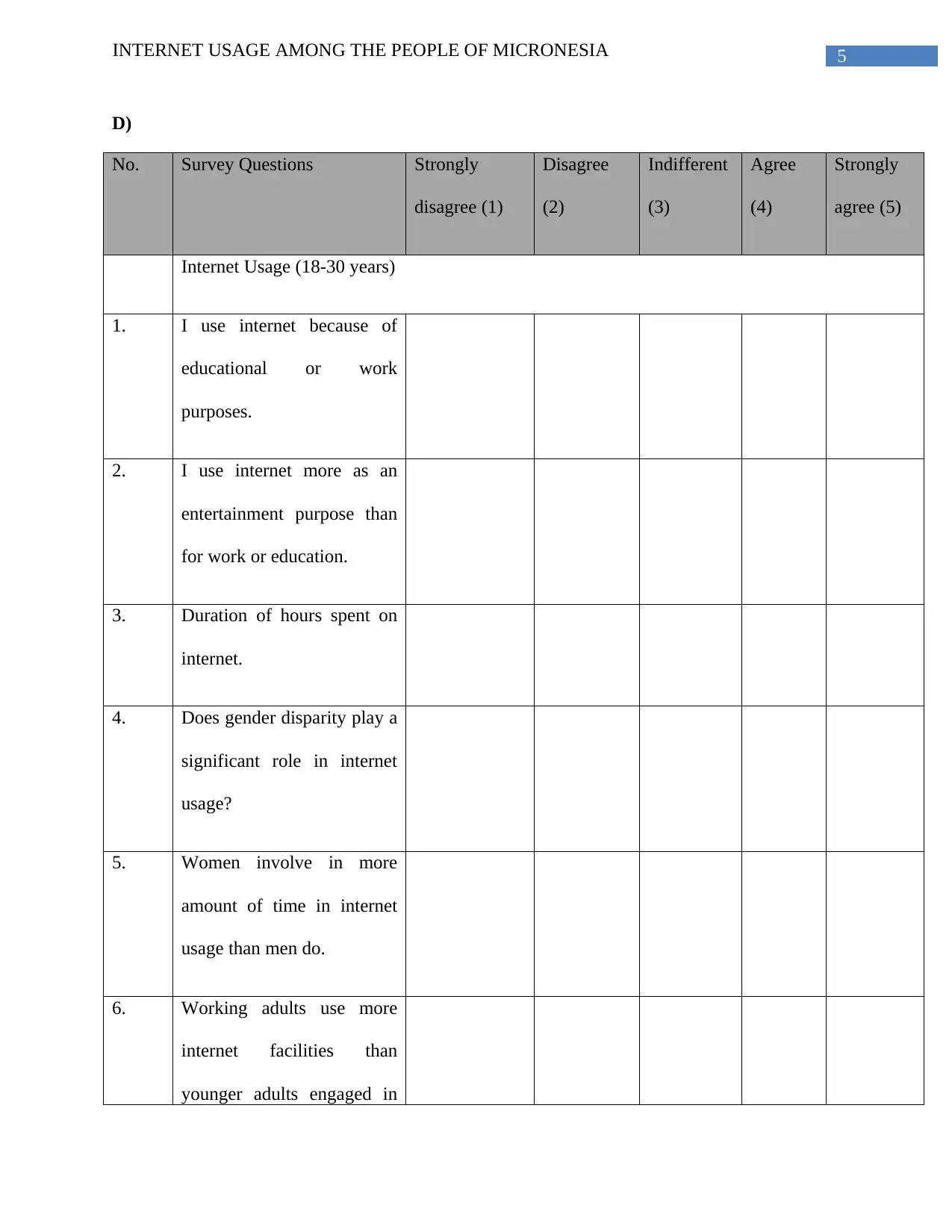
5INTERNET USAGE AMONG THE PEOPLE OF MICRONESIA
D)
No. Survey Questions Strongly
disagree (1)
Disagree
(2)
Indifferent
(3)
Agree
(4)
Strongly
agree (5)
Internet Usage (18-30 years)
1. I use internet because of
educational or work
purposes.
2. I use internet more as an
entertainment purpose than
for work or education.
3. Duration of hours spent on
internet.
4. Does gender disparity play a
significant role in internet
usage?
5. Women involve in more
amount of time in internet
usage than men do.
6. Working adults use more
internet facilities than
younger adults engaged in
D)
No. Survey Questions Strongly
disagree (1)
Disagree
(2)
Indifferent
(3)
Agree
(4)
Strongly
agree (5)
Internet Usage (18-30 years)
1. I use internet because of
educational or work
purposes.
2. I use internet more as an
entertainment purpose than
for work or education.
3. Duration of hours spent on
internet.
4. Does gender disparity play a
significant role in internet
usage?
5. Women involve in more
amount of time in internet
usage than men do.
6. Working adults use more
internet facilities than
younger adults engaged in
You're viewing a preview
Unlock full access by subscribing today!
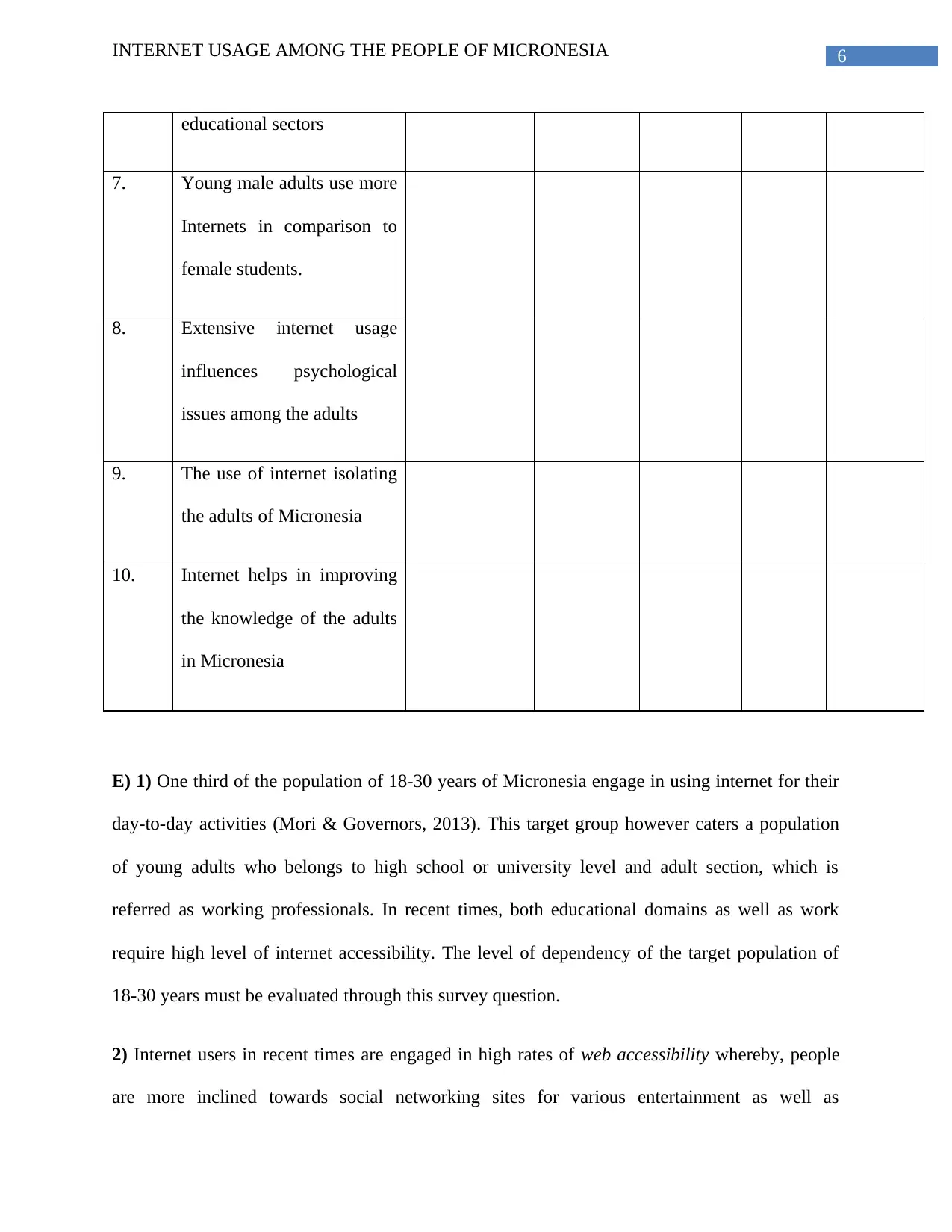
6INTERNET USAGE AMONG THE PEOPLE OF MICRONESIA
educational sectors
7. Young male adults use more
Internets in comparison to
female students.
8. Extensive internet usage
influences psychological
issues among the adults
9. The use of internet isolating
the adults of Micronesia
10. Internet helps in improving
the knowledge of the adults
in Micronesia
E) 1) One third of the population of 18-30 years of Micronesia engage in using internet for their
day-to-day activities (Mori & Governors, 2013). This target group however caters a population
of young adults who belongs to high school or university level and adult section, which is
referred as working professionals. In recent times, both educational domains as well as work
require high level of internet accessibility. The level of dependency of the target population of
18-30 years must be evaluated through this survey question.
2) Internet users in recent times are engaged in high rates of web accessibility whereby, people
are more inclined towards social networking sites for various entertainment as well as
educational sectors
7. Young male adults use more
Internets in comparison to
female students.
8. Extensive internet usage
influences psychological
issues among the adults
9. The use of internet isolating
the adults of Micronesia
10. Internet helps in improving
the knowledge of the adults
in Micronesia
E) 1) One third of the population of 18-30 years of Micronesia engage in using internet for their
day-to-day activities (Mori & Governors, 2013). This target group however caters a population
of young adults who belongs to high school or university level and adult section, which is
referred as working professionals. In recent times, both educational domains as well as work
require high level of internet accessibility. The level of dependency of the target population of
18-30 years must be evaluated through this survey question.
2) Internet users in recent times are engaged in high rates of web accessibility whereby, people
are more inclined towards social networking sites for various entertainment as well as
Paraphrase This Document
Need a fresh take? Get an instant paraphrase of this document with our AI Paraphraser
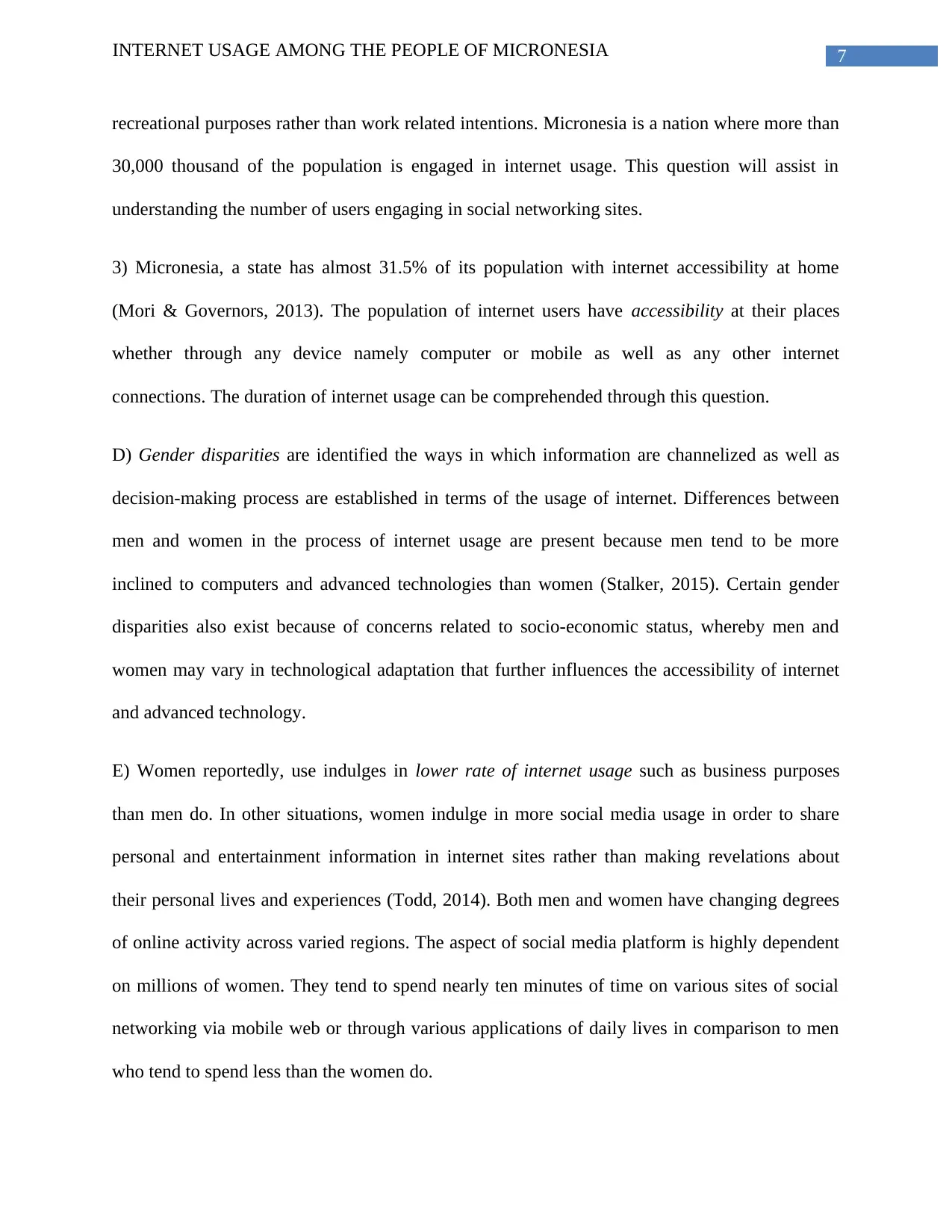
7INTERNET USAGE AMONG THE PEOPLE OF MICRONESIA
recreational purposes rather than work related intentions. Micronesia is a nation where more than
30,000 thousand of the population is engaged in internet usage. This question will assist in
understanding the number of users engaging in social networking sites.
3) Micronesia, a state has almost 31.5% of its population with internet accessibility at home
(Mori & Governors, 2013). The population of internet users have accessibility at their places
whether through any device namely computer or mobile as well as any other internet
connections. The duration of internet usage can be comprehended through this question.
D) Gender disparities are identified the ways in which information are channelized as well as
decision-making process are established in terms of the usage of internet. Differences between
men and women in the process of internet usage are present because men tend to be more
inclined to computers and advanced technologies than women (Stalker, 2015). Certain gender
disparities also exist because of concerns related to socio-economic status, whereby men and
women may vary in technological adaptation that further influences the accessibility of internet
and advanced technology.
E) Women reportedly, use indulges in lower rate of internet usage such as business purposes
than men do. In other situations, women indulge in more social media usage in order to share
personal and entertainment information in internet sites rather than making revelations about
their personal lives and experiences (Todd, 2014). Both men and women have changing degrees
of online activity across varied regions. The aspect of social media platform is highly dependent
on millions of women. They tend to spend nearly ten minutes of time on various sites of social
networking via mobile web or through various applications of daily lives in comparison to men
who tend to spend less than the women do.
recreational purposes rather than work related intentions. Micronesia is a nation where more than
30,000 thousand of the population is engaged in internet usage. This question will assist in
understanding the number of users engaging in social networking sites.
3) Micronesia, a state has almost 31.5% of its population with internet accessibility at home
(Mori & Governors, 2013). The population of internet users have accessibility at their places
whether through any device namely computer or mobile as well as any other internet
connections. The duration of internet usage can be comprehended through this question.
D) Gender disparities are identified the ways in which information are channelized as well as
decision-making process are established in terms of the usage of internet. Differences between
men and women in the process of internet usage are present because men tend to be more
inclined to computers and advanced technologies than women (Stalker, 2015). Certain gender
disparities also exist because of concerns related to socio-economic status, whereby men and
women may vary in technological adaptation that further influences the accessibility of internet
and advanced technology.
E) Women reportedly, use indulges in lower rate of internet usage such as business purposes
than men do. In other situations, women indulge in more social media usage in order to share
personal and entertainment information in internet sites rather than making revelations about
their personal lives and experiences (Todd, 2014). Both men and women have changing degrees
of online activity across varied regions. The aspect of social media platform is highly dependent
on millions of women. They tend to spend nearly ten minutes of time on various sites of social
networking via mobile web or through various applications of daily lives in comparison to men
who tend to spend less than the women do.
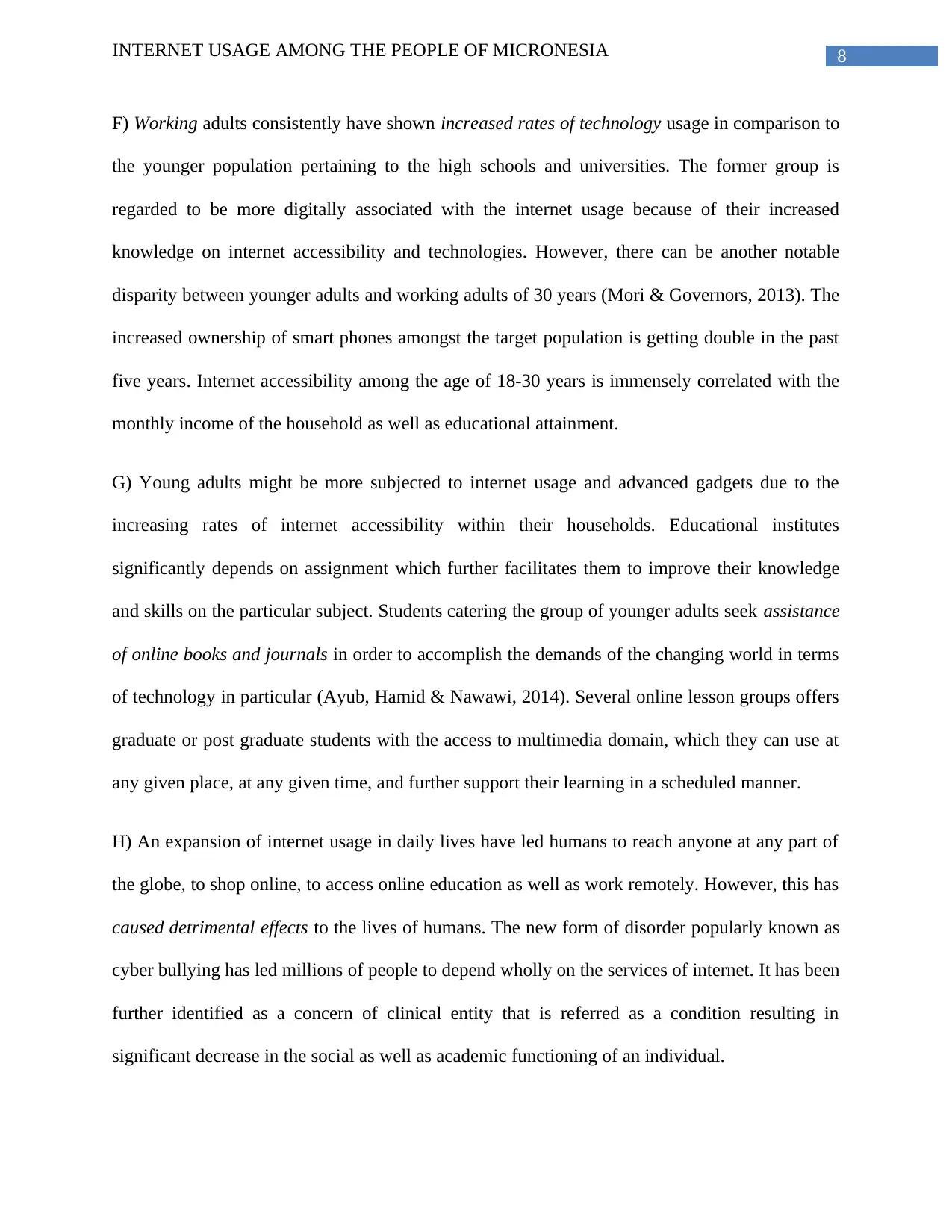
8INTERNET USAGE AMONG THE PEOPLE OF MICRONESIA
F) Working adults consistently have shown increased rates of technology usage in comparison to
the younger population pertaining to the high schools and universities. The former group is
regarded to be more digitally associated with the internet usage because of their increased
knowledge on internet accessibility and technologies. However, there can be another notable
disparity between younger adults and working adults of 30 years (Mori & Governors, 2013). The
increased ownership of smart phones amongst the target population is getting double in the past
five years. Internet accessibility among the age of 18-30 years is immensely correlated with the
monthly income of the household as well as educational attainment.
G) Young adults might be more subjected to internet usage and advanced gadgets due to the
increasing rates of internet accessibility within their households. Educational institutes
significantly depends on assignment which further facilitates them to improve their knowledge
and skills on the particular subject. Students catering the group of younger adults seek assistance
of online books and journals in order to accomplish the demands of the changing world in terms
of technology in particular (Ayub, Hamid & Nawawi, 2014). Several online lesson groups offers
graduate or post graduate students with the access to multimedia domain, which they can use at
any given place, at any given time, and further support their learning in a scheduled manner.
H) An expansion of internet usage in daily lives have led humans to reach anyone at any part of
the globe, to shop online, to access online education as well as work remotely. However, this has
caused detrimental effects to the lives of humans. The new form of disorder popularly known as
cyber bullying has led millions of people to depend wholly on the services of internet. It has been
further identified as a concern of clinical entity that is referred as a condition resulting in
significant decrease in the social as well as academic functioning of an individual.
F) Working adults consistently have shown increased rates of technology usage in comparison to
the younger population pertaining to the high schools and universities. The former group is
regarded to be more digitally associated with the internet usage because of their increased
knowledge on internet accessibility and technologies. However, there can be another notable
disparity between younger adults and working adults of 30 years (Mori & Governors, 2013). The
increased ownership of smart phones amongst the target population is getting double in the past
five years. Internet accessibility among the age of 18-30 years is immensely correlated with the
monthly income of the household as well as educational attainment.
G) Young adults might be more subjected to internet usage and advanced gadgets due to the
increasing rates of internet accessibility within their households. Educational institutes
significantly depends on assignment which further facilitates them to improve their knowledge
and skills on the particular subject. Students catering the group of younger adults seek assistance
of online books and journals in order to accomplish the demands of the changing world in terms
of technology in particular (Ayub, Hamid & Nawawi, 2014). Several online lesson groups offers
graduate or post graduate students with the access to multimedia domain, which they can use at
any given place, at any given time, and further support their learning in a scheduled manner.
H) An expansion of internet usage in daily lives have led humans to reach anyone at any part of
the globe, to shop online, to access online education as well as work remotely. However, this has
caused detrimental effects to the lives of humans. The new form of disorder popularly known as
cyber bullying has led millions of people to depend wholly on the services of internet. It has been
further identified as a concern of clinical entity that is referred as a condition resulting in
significant decrease in the social as well as academic functioning of an individual.
You're viewing a preview
Unlock full access by subscribing today!
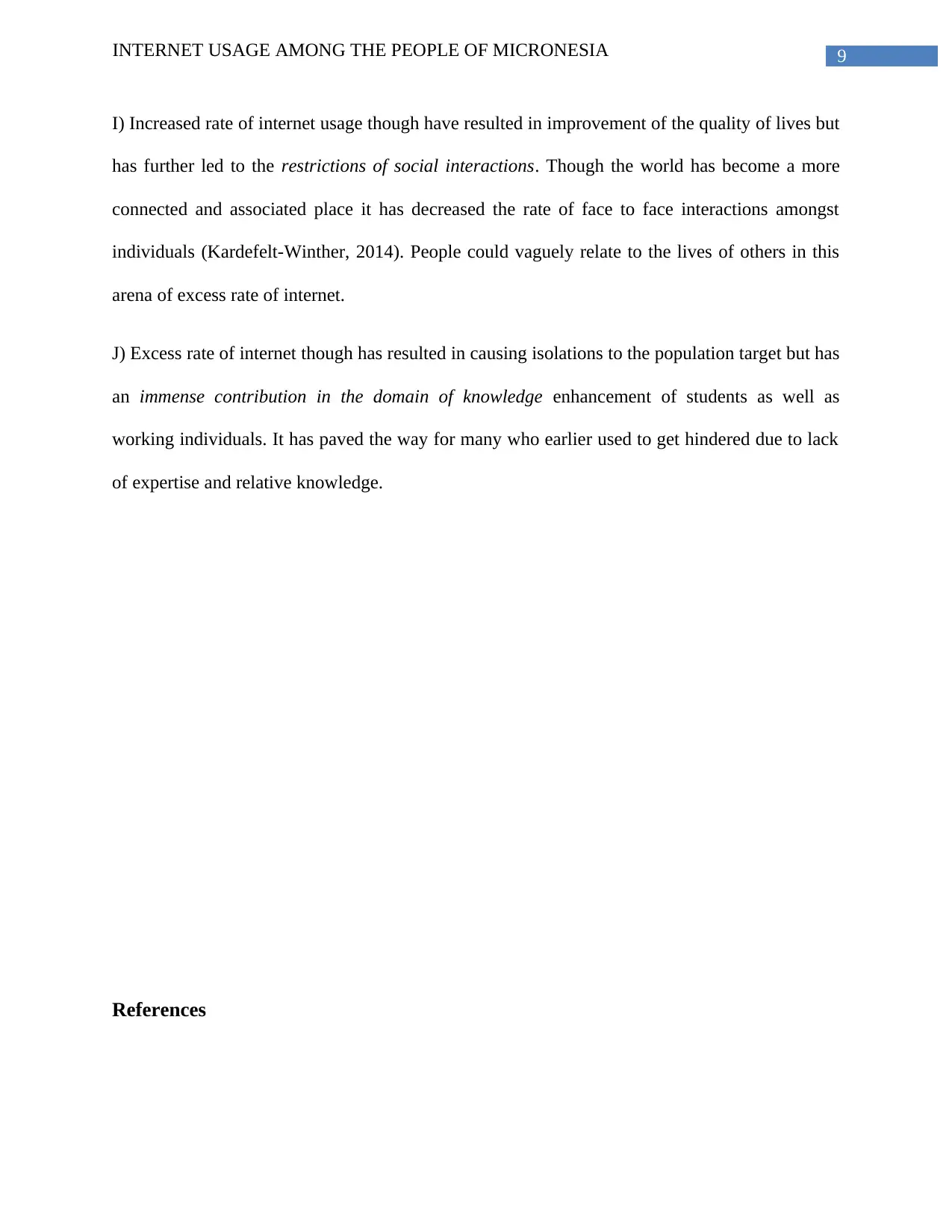
9INTERNET USAGE AMONG THE PEOPLE OF MICRONESIA
I) Increased rate of internet usage though have resulted in improvement of the quality of lives but
has further led to the restrictions of social interactions. Though the world has become a more
connected and associated place it has decreased the rate of face to face interactions amongst
individuals (Kardefelt-Winther, 2014). People could vaguely relate to the lives of others in this
arena of excess rate of internet.
J) Excess rate of internet though has resulted in causing isolations to the population target but has
an immense contribution in the domain of knowledge enhancement of students as well as
working individuals. It has paved the way for many who earlier used to get hindered due to lack
of expertise and relative knowledge.
References
I) Increased rate of internet usage though have resulted in improvement of the quality of lives but
has further led to the restrictions of social interactions. Though the world has become a more
connected and associated place it has decreased the rate of face to face interactions amongst
individuals (Kardefelt-Winther, 2014). People could vaguely relate to the lives of others in this
arena of excess rate of internet.
J) Excess rate of internet though has resulted in causing isolations to the population target but has
an immense contribution in the domain of knowledge enhancement of students as well as
working individuals. It has paved the way for many who earlier used to get hindered due to lack
of expertise and relative knowledge.
References
Paraphrase This Document
Need a fresh take? Get an instant paraphrase of this document with our AI Paraphraser
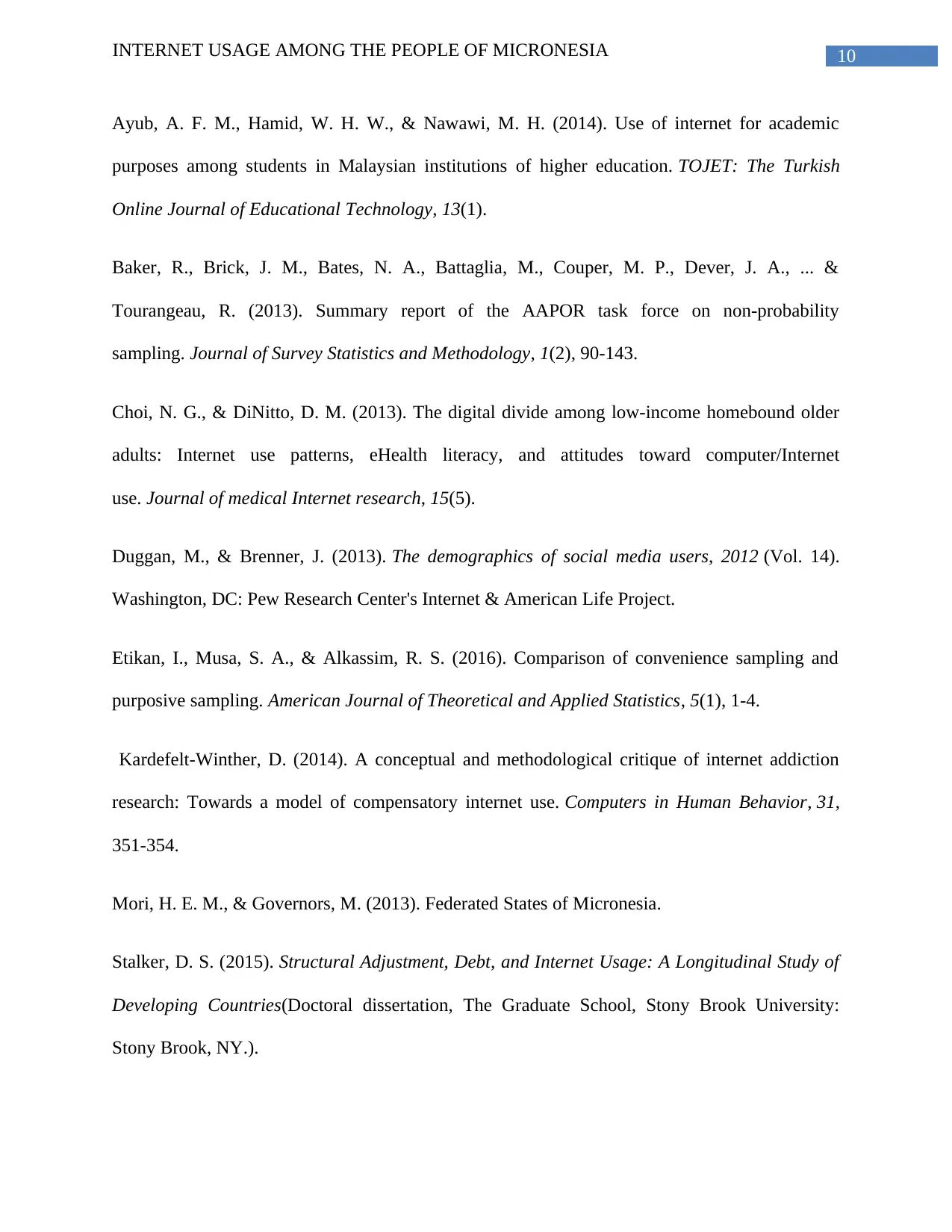
10INTERNET USAGE AMONG THE PEOPLE OF MICRONESIA
Ayub, A. F. M., Hamid, W. H. W., & Nawawi, M. H. (2014). Use of internet for academic
purposes among students in Malaysian institutions of higher education. TOJET: The Turkish
Online Journal of Educational Technology, 13(1).
Baker, R., Brick, J. M., Bates, N. A., Battaglia, M., Couper, M. P., Dever, J. A., ... &
Tourangeau, R. (2013). Summary report of the AAPOR task force on non-probability
sampling. Journal of Survey Statistics and Methodology, 1(2), 90-143.
Choi, N. G., & DiNitto, D. M. (2013). The digital divide among low-income homebound older
adults: Internet use patterns, eHealth literacy, and attitudes toward computer/Internet
use. Journal of medical Internet research, 15(5).
Duggan, M., & Brenner, J. (2013). The demographics of social media users, 2012 (Vol. 14).
Washington, DC: Pew Research Center's Internet & American Life Project.
Etikan, I., Musa, S. A., & Alkassim, R. S. (2016). Comparison of convenience sampling and
purposive sampling. American Journal of Theoretical and Applied Statistics, 5(1), 1-4.
Kardefelt-Winther, D. (2014). A conceptual and methodological critique of internet addiction
research: Towards a model of compensatory internet use. Computers in Human Behavior, 31,
351-354.
Mori, H. E. M., & Governors, M. (2013). Federated States of Micronesia.
Stalker, D. S. (2015). Structural Adjustment, Debt, and Internet Usage: A Longitudinal Study of
Developing Countries(Doctoral dissertation, The Graduate School, Stony Brook University:
Stony Brook, NY.).
Ayub, A. F. M., Hamid, W. H. W., & Nawawi, M. H. (2014). Use of internet for academic
purposes among students in Malaysian institutions of higher education. TOJET: The Turkish
Online Journal of Educational Technology, 13(1).
Baker, R., Brick, J. M., Bates, N. A., Battaglia, M., Couper, M. P., Dever, J. A., ... &
Tourangeau, R. (2013). Summary report of the AAPOR task force on non-probability
sampling. Journal of Survey Statistics and Methodology, 1(2), 90-143.
Choi, N. G., & DiNitto, D. M. (2013). The digital divide among low-income homebound older
adults: Internet use patterns, eHealth literacy, and attitudes toward computer/Internet
use. Journal of medical Internet research, 15(5).
Duggan, M., & Brenner, J. (2013). The demographics of social media users, 2012 (Vol. 14).
Washington, DC: Pew Research Center's Internet & American Life Project.
Etikan, I., Musa, S. A., & Alkassim, R. S. (2016). Comparison of convenience sampling and
purposive sampling. American Journal of Theoretical and Applied Statistics, 5(1), 1-4.
Kardefelt-Winther, D. (2014). A conceptual and methodological critique of internet addiction
research: Towards a model of compensatory internet use. Computers in Human Behavior, 31,
351-354.
Mori, H. E. M., & Governors, M. (2013). Federated States of Micronesia.
Stalker, D. S. (2015). Structural Adjustment, Debt, and Internet Usage: A Longitudinal Study of
Developing Countries(Doctoral dissertation, The Graduate School, Stony Brook University:
Stony Brook, NY.).
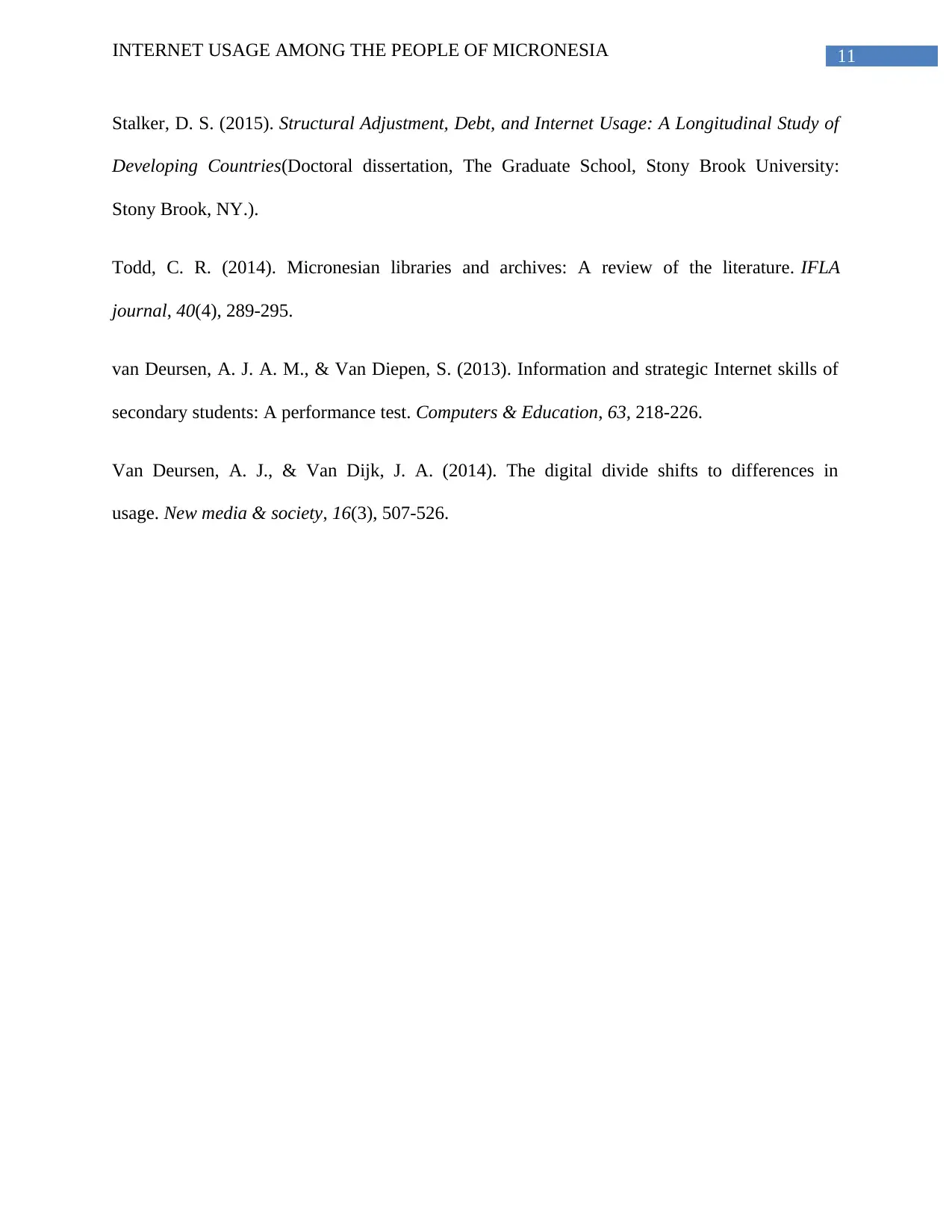
11INTERNET USAGE AMONG THE PEOPLE OF MICRONESIA
Stalker, D. S. (2015). Structural Adjustment, Debt, and Internet Usage: A Longitudinal Study of
Developing Countries(Doctoral dissertation, The Graduate School, Stony Brook University:
Stony Brook, NY.).
Todd, C. R. (2014). Micronesian libraries and archives: A review of the literature. IFLA
journal, 40(4), 289-295.
van Deursen, A. J. A. M., & Van Diepen, S. (2013). Information and strategic Internet skills of
secondary students: A performance test. Computers & Education, 63, 218-226.
Van Deursen, A. J., & Van Dijk, J. A. (2014). The digital divide shifts to differences in
usage. New media & society, 16(3), 507-526.
Stalker, D. S. (2015). Structural Adjustment, Debt, and Internet Usage: A Longitudinal Study of
Developing Countries(Doctoral dissertation, The Graduate School, Stony Brook University:
Stony Brook, NY.).
Todd, C. R. (2014). Micronesian libraries and archives: A review of the literature. IFLA
journal, 40(4), 289-295.
van Deursen, A. J. A. M., & Van Diepen, S. (2013). Information and strategic Internet skills of
secondary students: A performance test. Computers & Education, 63, 218-226.
Van Deursen, A. J., & Van Dijk, J. A. (2014). The digital divide shifts to differences in
usage. New media & society, 16(3), 507-526.
You're viewing a preview
Unlock full access by subscribing today!
1 out of 12
Related Documents
Your All-in-One AI-Powered Toolkit for Academic Success.
+13062052269
info@desklib.com
Available 24*7 on WhatsApp / Email
![[object Object]](/_next/static/media/star-bottom.7253800d.svg)
Unlock your academic potential
© 2024 | Zucol Services PVT LTD | All rights reserved.





